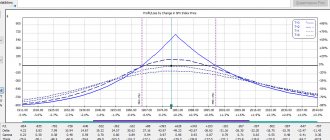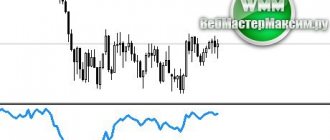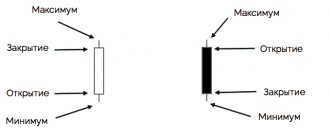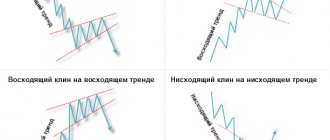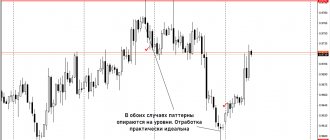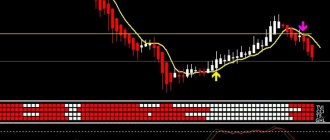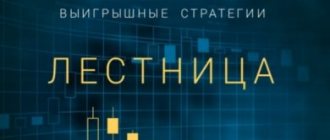Price Action is built on patterns - repeated behavior of a chart under the same conditions. This is what made it possible to highlight a set of Price Action figures; their combination with levels provides an excellent basis for a trading strategy. You can work with these patterns on an almost blank chart, the relationships between the elements of the models are quickly remembered, all that remains is to build the levels and assess the state of the Forex market as a whole.
When trading, we recommend striving for maximum signal reliability. Therefore, use the patterns discussed below only with signal confirmations. We will talk about this in more detail during a detailed analysis of each RA model.
Doji Patterns
A doji is a candle whose opening and closing prices are equal or almost equal. There should also be shadows on both sides of the candle, approximately the same size.
Before the Doji candle there should be a full-bodied candle of medium or large size in the direction of the trend. It is this candle that determines the character of the doji.
When trading Doji, you should wait for confirmation, that is, another candle should appear after the Doji appears. If the last candle closes in the direction of the previous trend, we get a Price Action pattern “Move – Congestion – Move” or “Movement – Consolidation – Movement” – a trend continuation pattern. If the last candle is against the established trend, we have a Price Point Reversal or “Reversal Point” pattern. In the Japanese version, the pattern is called “Morning or Evening Doji Star”. The exact same pattern, but just with a small candlestick instead of a doji, is simply called the “Morning or Evening Star”. If there is a gap between the doji and the surrounding candles, then this pattern turns into the “Abandoned Baby” pattern. Since gaps are a rare occurrence in the Forex market, we will not highlight this pattern separately.
As for the Doji candle itself, it comes in three varieties:
- The Doji star has a very small body (up to 10%) or no body at all, the candle size itself is small (up to 0.6 ATR);
- The second variety - the tombstone doji - is very similar to a pin bar, only with virtually no body;
- The third variety is the doji rickshaw - this candle has a small body that is located approximately in the middle of the candle and fairly large shadows on both sides of approximately the same size.
Also, often speaking about a Doji candle, they mean a small candle (up to 0.6 ATR) with a small body (up to 30% of the length of the entire candle). For the purposes of this study, we will call this candle a non-strict Doji.
Now let's determine the frequency of occurrence of such a pattern on the charts of different currencies of different periods. Here we will not use any filters or confirmations. Let's simply check the very fact of the appearance of a medium or long full-bodied candle with a Doji candle of one of the four types.
As you can see, the frequency of occurrence of the pattern on daily charts is quite small. However, during the periods H4 and H1, the pattern appears quite often.
MDZ indicator and price action setups
Unlike the previous tool, the MDZ indicator not only identifies patterns on the chart, but also gives a signal to open a new trade.
The indicator can perform the following functions:
- Identify trend lines on a chart.
- Highlight strong resistance and support levels.
- Identify patterns simultaneously on several TFs - working and additional.
- Show basic information about the found setup (graph TF, where the pattern was found, asset value, age of the pattern on history, etc.).
MDZ is suitable for trading using various strategies - scalping, trend, counter-trend, etc. It is often used to enter into transactions when a correction ends or when one trend changes to another.
Test all patterns together
This is what pattern trading looks like on the H1 period on the currency pairs we are considering:
If we replace the standard stop based on the candle shadow with a stop based on the ATR indicator, we get the following result:
You can also add a trailing stop based on the shadows of the candles to the trading system - we will pull up our initial stop loss following the price based on the shadows of the candles:
But what happens if you use the opposite signal to exit a position:
During the H1 period, trading all the PA patterns discussed in the article gave a quite pleasant-looking yield curve. At the same time, over 10,000 transactions over 17 years tell us that you will not be bored with such trading - at least 2 transactions per day should be obtained.
Now let's look at trading on the H4 period:
Let's apply stops of 2-4 ATR:
Let's attach the trailing stop:
Now let’s add an exit condition based on the return signal:
The best option when trading on H4 is using stops based on the ATR indicator and active position management. However, there are not much fewer transactions than when trading on H1. But there are much fewer nerves.
Step-by-step instructions on Price Action for beginners
I will tell you about trading on a pure chart without using indicators - Price action. You will immediately start making profits and learn not to lose your money. You don't have to calculate multiples and hold shares for 10 years or more to make a profit. We will be trading, not investing. Simple, clear and stress-free.
Preface
I want to say right away that we will not dive very deeply into the topic, draw block levels, learn to identify extreme points, look at VSA, candlestick combinations, consolidation, swing trading, trend strength and acceleration, false breakouts and channels, because...
This will turn out to be an incredibly huge article. But, even with basic knowledge, you will already be able to trade and create your own trading strategy, which you can further improve and supplement. Professional traders, don't be so harsh.
Results of transactions for the last month with 1 million
All my transactions are in Pulse and my ETP Trading telegram channel.
Introduction
You can trade on any broker, it doesn’t matter. For example, I have a broker that is constantly buggy and because of which I recently lost money, and in return I received a “Sorry.” You just have to look at whether it is possible to plot various elements on the stock chart in your broker’s terminal.
If this is not possible, then you can use the TradingView website; the free version is completely sufficient for technical analysis.
What is Price Action
Price Action translated from English means “price movement”. The founder of technical analysis, Charles Dow, argued that price includes all necessary information, be it economic news or political news.
The price movement encrypts everything that happens in the foreign exchange market. Quickly study and understand the essence of price movement, instead of reading kilometers of news announcements and analytical calculations.
Charles Henry Dow - Invented the famous Dow Jones Industrial Average, founded The Wall Street Journal, and is the founder of technical analysis.
Fundamental and technical analysis
Using technical analysis, future price changes are predicted based on an analysis of past and current price changes. It is based on the analysis of price time series, most often charts with different time frames.
Fundamental analysis is based on a study of the company's economic, financial and production indicators and their investment attractiveness. To determine with a high degree of reliability the real or “fair” value of securities.
Below is a comparison chart of yields.
Yellow - Cathie Wood Fund, Red - Warren Buffett, White - NASDAQ, Green - S&P 500.
A clear difference between the technical approach and the fundamental one.
Some sit and hatch their eggs for 20 years with their fundamental calculations based on multipliers with the search for promising stocks, and at the same time the growth of their profitability is lower than that of the main indices, while others choose promising stocks/directions and earn money here and now based on the movement prices.
The stock will certainly grow in 5-10 years, but are you ready to wait that long?
The profitability of Tesla shares for 1 year is 728%, which a fundamental investor will never buy, but a trader with equipment will buy. P/E is currently 1256.
I am not belittling the importance of fundamental analysis, but if you are not Warren Buffett and you do not have a billion, and you are not willing to sit and wait for several years, then it is better to look towards technical analysis.
Trend Determination
Charles Dow's definition of a trend is as follows: in an uptrend (downtrend), each subsequent peak and each decline must be higher (lower) than the previous one.
How can you determine when the trend has changed? Using the example of an upward trend and the Zoom stock, which changed to a downward one.
Changing the trend from up to down
As soon as the last low became lower than the penultimate low, the trend changed from upward to downward. Next, according to the technique, there is a retest and we get a mirror level, which is strong.
To change the trend from downward to upward, everything is similar, only mirrored.
Multiframe analysis
Plus or minus, we understand how the trend changes, now we need to decide on which timeframe to trade.
A timeframe is a time interval that is used to group prices when constructing elements of a price chart.
In simple human words, this is how long it takes to form a candle on the chart.
Actually, if we choose 4 hours, then we will get 6 candles per day. If it is 1 hour, then this will already be 24 candles per day, etc.
There are 6 periods in total:
- M - minute (1m - minute period).
- H - hour (4h - four-hour period).
- D - day (D or 1D - day period).
- W - week (W or 1W - weekly period).
- M - month (M or Mo - monthly period).
- Y - year (Y or 1y - annual period).
The shorter the period, the more noise and false breakouts/movements on the chart. For scalping, 1m-5m-10m minute timeframes are used, for the medium term 1h-4h-1d, for positional trading DWM.
Multiframe analysis is trading using multiple timeframes, which allows you to enter a trade more accurately. For example, you build support and resistance levels at 4h, but look for a breakout at 1h; as a result, your entry can be 4 times more accurate.
The most important thing is to understand that if you trade on 4h, then you don’t care what happens on minute timeframes, if everything falls there, then let it fall, only your working timeframe is important to you.
Support and resistance levels
The resistance level is a horizontal line that passes through the maximum price extremes and indicates the dominant position of sellers over buyers.
The support level is also a horizontal line, but it passes through the minimum extremes.
There are also mirror levels, this is when resistance has become support and vice versa.
Price Action Patterns
We learned how to determine the trend and draw support and resistance lines. But when should you enter into a trade?
Let's move to the lower timeframe and watch the formation of a pattern on the resistance/support line.
Patterns are repeating elements on graphs that reflect certain patterns.
There are a large number of patterns, but let’s look at the simplest and most basic ones.
Pin bar
Absorption
Head and shoulders
Inverted head and shoulders on Lukoil shares with subsequent growth.
The head and shoulders can be normal or upside down, as in the screenshot. This is a strong pattern followed by a strong movement.
Double top
Double top on the Tesla chart. After formation there is a fall.
Double bottom
A pattern has formed with a double bottom for Apple shares, followed by growth.
In total, as soon as the pattern has formed, you can enter.
Entry point and stop loss
Examples of when and how you can enter a stock when a level is broken.
1) We go to the breakout of the level (green block) using a limit order and place a stop behind the minimum of the breakout candle.
2) We enter after confirmation of the breakout with the next candle, there should be a green candle after the breakout, stop behind 1 breakout candle.
3) We enter after a retest (yellow line), when there was growth, after the price drops back to the level, for its retest, we again wait for growth above the last maximum (white line) and only then enter. Stop for the entire pattern.
The effectiveness of option 1 is 50/50, option 3 is already 90%, but we can miss a lot of profit and usually PLR does not converge, but this is the ideal option according to all textbooks with technical analysis. Option 2 is average and sometimes the confirmation candle flies too far, which does not allow entry.
Profit fixation points (take profit)
Everything is simple here. We fix on the following levels of resistance/support or extremes/turning points, based on whether we short the stock or take it long.
The most important thing is that after the first take we always move the stop to breakeven, i.e. at the price at which the shares were purchased. Therefore, even if the price falls, you will remain with your money.
Ready trading system
The strategy is simplified as much as possible for beginners, but the main and important points remain.
- We look at the general trend, first try to trade on a growing trend,
- We look at the resistance/support levels on the main timeframe,
- Let's switch to the lower timeframe and look for reversal patterns,
- We enter according to the setup and set a stop loss,
- We put takes,
- After the first take, we set a hard stop at breakeven.
Thank you for reading to the end!
I regularly share my opinion on the current state of the market, write educational articles and publish my trades “live” on my telegram channel “ETP Trading”.
If you were interested in the article and gained knowledge, you can subscribe and receive up-to-date information directly.
Neil Fuller and his books.
Neil Fuller is a trader who makes money on Price Action . He shares his knowledge about the market through his articles.
Neil Fuller, supposedly successful trader.
The rules of this trader are:
- No rush
- Day trading
- Without a stop loss there is no way,
- Maintaining a journal of transactions.
This is a truly smart approach to trading.
Lack of haste is not only a careful choice of entry signal. It’s also about getting the maximum profit from a transaction and holding a position as long as it makes money. Sometimes it’s not hours or days, but whole months. That's how good it is, you can get into a trend!
Absorption is trending.
This price action pattern is formed at trend extremes. The appearance of a bullish setup on a rollback of an uptrend indicates the continuation of this trend. Also with a bearish setup, on a downtrend. Bearish engulfing occurs at a new high in a downtrend. This indicates the strength of sellers in the trend. In a downtrend there may also be a bullish engulfing at the minimum. But this is unlikely to be a signal for a reversal of the entire trend.
Remember - any trend begins with a friend and ends with a friend. According to statistics, a reversal occurs only in 30% of cases; more often, a flat accumulation occurs with subsequent continuation. Read more in the article “trend cycles”
Risk-to-reward ratio in the absorption model.
There are several options when you need to take profits. An open transaction must have positive mathematical expectations. This is the only way a trader can make money.
The ratio is 1 to 2, 1 to 3 and so on. In this case, the trader has a positive expectation. But a fixed profit does not always fit into market conditions. The price moves from level to level. This means that profit can be recorded near these levels. Having determined the levels in advance, it will immediately be clear what the potential of the transaction is (ratio) 1 to 1, 1 to 2 or more. If you can’t take a ratio of at least 1 to 2, you should think about opening this trade. But when the decision is made to open a trade, this should be done with a reduced volume.
Stoplos in strategy.
When trading this pattern, you must understand your stop. In principle, the success of trading will depend on this. Stop installation methods:
In bearish and bullish PPR setups. There are two ways to set a stop. In the first, the stop is set beyond the minimum/maximum of the last candle. In the second, the stop is placed beyond the minimum/high of the second candle. In the picture it looks like this.
Writing materials on trading in text is very difficult. It is much easier to do them in video format. This is what we have been doing for more than 6 years! Subscribe to us and get the cream of information!
YouTube channel
Steve Nison books about Japanese candlesticks
Japanese candlesticks are the most popular way to visualize prices. This method is used by many traders around the world. A detailed analysis of Japanese candlesticks allows you to examine the market in more detail
Nilsson's book about Japanese candles is a real legend from all the literature about Japanese candles. The book was published in 1991. There are two of his books about Japanese candles. The first book, “Japanese Candlesticks and Analysis of Financial Markets,” is black. The second “beyond Japanese candlesticks” is red. These are classic covers, first editions.
These books deal with candlestick analysis. For those who are engaged in this particular type of market analysis, it is recommended to read. Lots of patterns, and detailed analysis of candlestick patterns. All this will create a complete picture of trading, with Japanese candlesticks. In addition to the technical component, in the first book the author talks about the history of Japanese candlesticks. Oddly enough, this method of graphical analysis appeared in Japan. All this is said in books.
The book “Graphical analysis of financial markets”, or in the Russian translation “Japanese candlesticks”. Has more than 50 types of combinations with candles. Each candlestick model has its own unique name. Here you will find a hammer, butterflies and many other living creatures.
The books were written by a person who actually both lost and made money in the market. His opinion is worth listening to, because his words are supported by practice and real experience.
Example from Steve Nison's book “Japanese Candlesticks”
Steve Nison's graphical analysis revolutionized analytics. The book is addressed to both beginners and practicing traders. The author conveys the idea that by understanding candlestick patterns, you can analyze the market with high accuracy.
Receive free signals on the stock market and futures. You don’t need to register anywhere, replenish your account – the same. Just subscribe to our pages and receive quality information quickly and with a guarantee.
How to distinguish a good signal from a bad one
There is no strategy that gives accurate signals all the time. A trader will have to learn to distinguish between false signals and good ones. The editors of binium.ru have prepared 7 tips based on the Pin Bar reversal pattern; most can be used with other models.
The tail should create a false breakout. The probability of a pin bar triggering increases significantly if part of the pattern breaks through the horizontal support/resistance level. A false breakout indicates an inability to hold the price below or above the level.
The longer the tail, the stronger the signal. The length of the pin bar wick shows the size of the failure. The length indicates the probability of a reversal.
A candlestick can also indicate a continuation of a trend if it is formed during a flat.
Always wait for confirmation. Do not trade for a breakout of the level after the signal has been formed. Breakouts often turn out to be false. Wait for a close outside of support/resistance or a rebound.
A pin bar with a large tail works better after a long movement. The longer the price goes in one direction, the more effectively the pattern works.
After a pullback to a key level, look for confirmation of the trend. One of the most important filters is the expectation of a rollback to a key level in a trending market.
Don't trade inside a consolidation. During periods, the formation of several pin bars in a row is possible - do not consider it as a signal. Wait for confirmation of the flat breakdown.
Don't trade in times of uncertainty. If a signal is formed where there are no key levels and other confirming factors, do not enter the market.
BREAKTHROUGH in your trading!
This information is superbly applied to trading using VSA methods. In fact, this information can make a breakthrough in your trading.
Make a breakthrough in trading!
Stop order in the Price Action – PPR strategy
Placing a stop order for the minimum/maximum of the candle, best on TF H4. On lower timeframes, this will be ineffective. The minimum/maximum of a candle often does not break through on larger TFs. In this case, the trader is protected from false takeaways.
In bearish and bullish PPR setups. There are two ways to set a stop. In the first, the stop is set beyond the minimum/maximum of the last candle. In the second, the stop is placed beyond the minimum/high of the second candle. In the picture it looks like this.
Subscribe now:
Telegram
Review of the book on Price Action by Steve Nison.
The first thing I saw when I started trading it on the stock exchange was Japanese candlesticks. I was looking for a lot of information on how to trade using Japanese candles. I drew patterns, looked for regularities in the figures. I really enjoyed analyzing the market using candlestick analysis. I wanted to learn about making Japanese candles. After learning about these books, I read them completely. This very well complemented my knowledge of candlestick analysis. Not everyone understands trading with candles, but I understood this author’s books very well. Now I continue to trade using candlestick analysis. I also probably know all the combinations of Japanese candlesticks. They occur very often in the trading process. And they often give a good signal to enter.
